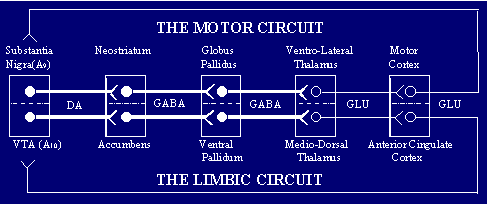MISSION STATEMENT
To probe the neural circuitry of intact conscious brain for new sites of intervention in the treatment of neurological and psychiatric disease.Background
In the past decade there has been a marked increase in knowledge of how motor and limbic circuitry are altered in Parkinsonís disease and schizophrenia respectively. The Ďcore defectí in Parkinsonís disease is the loss of the substantia nigra (A9) dopamine cell body projection to the neostriatum - two key regions in the motor circuit while recent histopathological evidence suggests that schizophrenia is a disorder in the limbic circuit where alterations in glutamate (GLU), GABA and dopamine (DA) transmission in the anterior cingulate gyrus play a role in the pathophysiology of this disease. The anterior cingulate - the medial prefrontal cortex (mPfc) in the rat - provides important routes of information between the frontal lobe and other brain regions implicated in schizophrenia such as the ventral tegmental area (VTA) .Simplified schematic representation of parallel nerve pathways in motor and limbic circuitry showing possible new sites of intervention.

In terms of the drug treatment of schizophrenia, the mPfc is just a synapse away from the VTA (A10) dopamine cell bodies and it is postulated that the ability of neuroleptics to block VTA - accumbens dopamine transmission in the limbic circuit underlies their antipsychotic profile while the parkinsonian side effects are due to blockade of the nigrostriatal dopamine transmission in the motor circuit. We propose to investigate the functional neuroanatomy of each of the pathways in these two neural circuits by studying the role of glutamate, GABA and dopamine receptor activation and blockade in the cell body region on neurotransmitter release in the terminal region using dual probe microdialysis in the intact conscious brain of the rat. The goal is to develop a biologically based, experimentally testable, in vivo model for evaluating the effects of novel anti-parkisonian and neuroleptic agents and surgical strategies in the treatment of neurological and psychiatric disorders. This approach allows us to follow up on the emerging findings of functional abnormalities in the brain of persons with Parkinsonís disease and schizophrenia by investigating how neurotransmitters modulate the relevant brain circuits in the intact conscious brain of the rat and to develop a model which will predict how disruptions in these circuits underlie the symptoms of the disease.